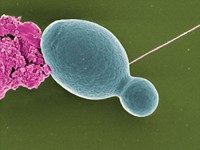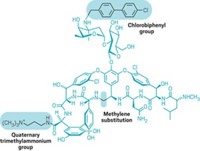Advertisement
Grab your lab coat. Let's get started
Welcome!
Welcome!
Create an account below to get 6 C&EN articles per month, receive newsletters and more - all free.
It seems this is your first time logging in online. Please enter the following information to continue.
As an ACS member you automatically get access to this site. All we need is few more details to create your reading experience.
Not you? Sign in with a different account.
Not you? Sign in with a different account.
ERROR 1
ERROR 1
ERROR 2
ERROR 2
ERROR 2
ERROR 2
ERROR 2
Password and Confirm password must match.
If you have an ACS member number, please enter it here so we can link this account to your membership. (optional)
ERROR 2
ACS values your privacy. By submitting your information, you are gaining access to C&EN and subscribing to our weekly newsletter. We use the information you provide to make your reading experience better, and we will never sell your data to third party members.
Pharmaceuticals
Amphotericin B Analogs Boast Lower Toxicity
Drug Discovery: Drugs based on new amphotericin B derivatives could have reduced side effects
by Stu Borman
June 4, 2015
| A version of this story appeared in
Volume 93, Issue 23
The natural product amphotericin B is an approved medication for treating some fungal infections, and fungi haven’t developed resistance to it. But the drug causes kidney damage, convulsions, heart failure, and other serious side effects. Researchers have now tweaked its molecular structure to create two versions that are much less toxic; are no more prone to resistance; and, according to the chemists, are readily synthesized and therefore amenable to industrial-scale production.

Martin D. Burke of the University of Illinois, Urbana-Champaign; Susan Lindquist of Whitehead Institute for Biomedical Research, in Cambridge, Mass.; and coworkers developed the agents and tested them in mice with a Candida yeast infection (Nat. Chem. Biol. 2015, DOI: 10.1038/nchembio.1821). Revolution Medicines, in Redwood City, Calif., cofounded by Burke, has licensed them exclusively for antifungal drug development.
Amphotericin B attacks fungi by binding the fungal sterol ergosterol. But it also binds cholesterol in people, leading to its side effects. The researchers modified amphotericin B’s structure to bind ergosterol but not cholesterol. Fungi still don’t develop resistance to the new agents, and the compounds can be synthesized from the natural product in three steps at up to 25% yield.
Erick M. Carreira of the Swiss Federal Institute of Technology (ETH), Zurich, says his group and others have developed similar amphotericin B derivatives that have antifungal activity and diminished toxicity as good as the new analogs. Burke says his team’s analogs demonstrated a greater range of safe doses, compared with those previous compounds, but Carreira replies that data reported in the new study are insufficient to substantiate that claim.
Fungal disease expert David W. Denning of the University of Manchester, in England, cautions that the new agents were tested against only one fungal infection and would need to be administered at doses too high to be useful. He adds that the real need is for oral agents, whereas the new agents, as is the case with amphotericin B, would have to be injected. Nevertheless, he calls the analogs’ low toxicity “remarkable,” their antifungal activity “impressive,” and the lack of fungal resistance against them “important.”





Join the conversation
Contact the reporter
Submit a Letter to the Editor for publication
Engage with us on Twitter